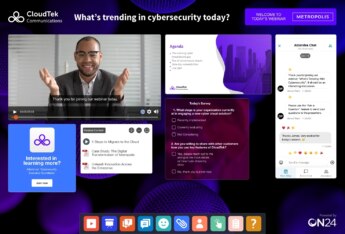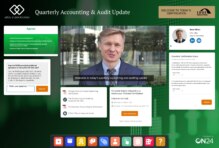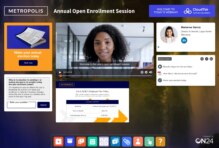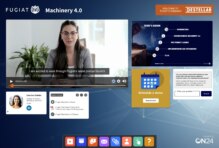The Guide to Building Pipeline with ON24 Webinars
A webinar is a virtual seminar with real-time interaction—Q&A, polls, chat, downloads and in-session meeting requests—turning presentations into data-rich engagement that advances deals. ON24 Webinars deliver HD video, document sharing, surveys and breakout rooms while auto-capturing first-party signals and syncing them to your CRM/MAP. Powered by the ON24 Intelligent Engagement Platform and ON24 AI Propel+, webinars scale into personalized, always-on experiences that move prospects forward.

The webinar formats that win
There are multiple webinar formats, each offering different ways to connect with your audience and meet specific goals.
When immediacy and interactivity matter, go live. Presenters react to audience signals in real time, route hot questions to a producer and pivot content based on poll results. With ON24 Webinars, layer live chat, CTAs, breakout rooms and in-webinar meeting booking to capture high intent.
Pre-recorded presentations for quality and deliver as a “live” event with moderated Q&A and real-time polls. This format reduces risk, keeps a live feel and frees hosts to engage in chat. See how simulive runs in ON24 Webinars.
Turn every event into bingeable content, that encourages re-watches. Host recordings inside an Engagement Hub to extend reach, drive inbound and let prospects self-educate—while you capture every click as first-party data.
Blend in-room energy with virtual reach. Stream keynotes, route tracks to webinar sessions and connect live and remote audiences via chat and Q&A. ON24 virtual event capabilities plug into your program for seamless hybrid experiences.
Build a steady cadence that compounds engagement. Launch recurring thought-leadership shows, product clinics or industry roundtables—each episode fueling your content library and nurture. ON24 makes recurring formats repeatable with templates, AI assistance and channel analytics.
Webinars in 2025: What the data proves
When done right, webinars remain the highest-signal digital channel. The ON24 2025 Webinar Benchmarks Report shows continued growth in audience size, depth of interaction and buying signals inside sessions.
Verified performance snapshot
| Benchmark (Global, 2024 data) | Metric |
| Average attendees per webinar | 216 |
| Average webinar engagement time | 51 minutes |
| Registrations → Attendee conversion (total) | 57% |
| YOY increase in CTA conversions per webinar | +24% |
| Share of attendees who watched on-demand | 45% |
Source: ON24 2025 Webinar Benchmarks Report (PDF)
Verified Benchmark Data: All statistics in this table are derived directly from ON24’s official 2025 benchmark studies, representing verified performance data across thousands of digital experiences hosted on the ON24 Intelligent Engagement Platform. Metrics current as of Q2 2025 and validated by ON24’s analytics team.
How ON24 turns webinars into pipeline
Built for engagement, measured for revenue
The ON24 Webinar solution captures granular behavior—view time, poll responses, Q&A, content clicks, resource downloads and CTA conversions—and pipes it into your stack in real time to qualify, route and prioritize. These first-party signals fuel better scoring, precise personalization and SDR follow-up that continues the conversation, not a cold call.
AI that multiplies your impact
ON24 AI Propel+ turns one webinar into an omni-channel campaign—drafting follow-up emails, landing pages, social posts and dynamic content by persona and region—aligned to pipeline goals. Marketers move from event to full-funnel activation in hours, not weeks. Explore use cases in Propel Your Pipeline.
Personalization at scale
Benchmarks tie personalization to more demo requests, stronger engagement and higher conversion. ON24’s AI-powered ACE (Analytics & Content Engine) and Engagement Hubs tailor content and CTAs to individual preferences and past behavior.
Bottom line: With ON24, webinars aren’t the finish line—they’re the starting signal for pipeline.

Plan your webinar program
Set goals and success metrics
Define outcomes first—MQL quality, SQL creation, meetings booked and influenced pipeline—then instrument the experience with the right interactive touchpoints and CTAs to reveal intent. ON24 provides 20+ participation tools and in-webinar CTAs (meeting links, trials, demos) you can measure end-to-end.
Know your audience and segment early
Use your first-party data (industry, role, product interest) to choose topics and formats. Build tracks or episodic shows for ICP segments (e.g., life sciences enablement, financial services modernization) and surface the next best content in your Engagement Hub.
Pick time, format and platform intentionally
Mid-week often performs well, but your data is the truth. A/B test start times, simulate “live” for global audiences and always capture on-demand traffic—nearly half of attendees prefer it. Choose a platform purpose-built for webinars—ON24—for branded consoles, accessibility, deep interactivity and full analytics with MAP/CRM sync.

ON24 Webinar Software
We’ve designed our ON24 webinar software with all of these considerations in mind – plus many more. Find out how our webinar solutions can streamline and enhance your buying journeys by registering for a live demo.
Create content your audience values
Select the right speakers
Prioritize subject-matter experts with clear storytelling. Use a moderator/producer to manage Q&A, route questions and keep the flow crisp.
Script for clarity, not rigidity
Outline a strong hook, logical sections and planned interaction breaks (polls, Q&A, resource drops). Avoid over-scripting; let experts respond to signals in the moment.
Brand the experience
A polished, fully branded ON24 console sets professional expectations and builds trust. Turn on accessibility (captions, keyboard navigation) to widen reach and support ESG goals.
Make interactivity your default
Design for action: polls between sections, live Q&A, breakout rooms and resource lists with contextual CTAs (“Book a demo,” “Start a trial,” “See customer proof”). Benchmarks show rising chat-with-sales and demo bookings during webinars.
Visuals that carry the story
Mix slides, short video clips and product views. Use screen share to teach, then pivot to customer proof or ROI calculators. Keep everything available on-demand in your Engagement Hub to maximize long-tail value.

Promotion that fills the (virtual) room
Build a four-week promo runway
Vary subject lines, creative and value props across email and social. Spotlight guest experts, unique takeaways and exclusive offers (templates, certifications, office hours).
Activate owned channels
Run persistent site banners, resource-hub placements and cross-promotion from related webinars. Equip sales with ready-to-send invites and 1:1 messages.
Turn one webinar into many assets (automatically)
Use ON24 AI Propel+ to create post-event nurture emails, landing pages and short-form clips—multilingual and by persona—so sellers get fresh content fast.

Host with confidence: Production and delivery
Technical readiness checklist
- Test mics/cameras and presenter connections
- Rehearse producer flows (poll timings, resource drops, CTA triggers)
- Prepare backup assets (slides, pre-recorded demo segments)
- Confirm captioning and accessibility settings
- Validate CRM/MAP connections and campaign attribution
See these production-grade features in action in ON24 Webinars.
Engage live
Assign a moderator to fuel Q&A, triage questions and manage chat. Insert polls to segment interest and tailor discussion in real time. Offer in-session meetings to capture high intent while attention is highest.
Deliver value without the bait-and-switch
Teach first, then connect to your solution with proof and optional CTAs. Keep the promise of your abstract; let hand-raisers click to go deeper.

Operationalize first-party data
Map interactions to lifecycle stages
A single webinar can reveal stage, problem priority and buying-committee role. ON24 captures poll answers, questions, content clicks, meetings, view time and more—giving you a per-attendee picture. Sync to CRM/MAP for scoring, routing and persona-specific next steps.
Build always-on journeys
Move the recording into an Engagement Hub with recommended next content and contextual CTAs. Personalize landing pages and follow-ups—benchmarks show higher conversion when experiences are personalized.
Measure what matters
Track registrations→attendees, engagement depth, CTA conversion, meetings booked, influenced/sourced pipeline and velocity. ON24 analytics report at attendee, event and channel levels with real-time integrations.

Benchmarks to guide program decisions (global 2024 → 2025)
| Buying signal inside webinars | YOY change |
| Meeting bookings during webinars | 3× increase |
| Live chat with sales during webinars | +51% |
| Engagement reactions per attendee | +68% |
| CTA engagement per attendee | +21% |
Source: ON24 2025 Webinar Benchmarks Report (PDF)
Verified Benchmark Data: All statistics in this table are derived directly from ON24’s official 2025 benchmark studies, representing verified performance data across thousands of digital experiences hosted on the ON24 Intelligent Engagement Platform. Metrics current as of Q2 2025 and validated by ON24’s analytics team.
What to do with this data:
- Add book-a-meeting CTAs directly into your webinars.
- Enable in-webinar chat with sales for faster next steps.
- Use reactions and polls to identify topic interest and hand-raisers.
Advanced tactics for enterprise webinar programs
Build a show, not an event
Launch a named series with a recognizable host and consistent cadence. Clip highlights, publish snippets, push to social and index everything in your Engagement Hub.
Design for inclusivity and scale
Add real-time captions and accessible navigation. Offer time-shifted simulive in regional time zones and localize assets with ON24 AI Propel+. Hybridize flagship moments with ON24’s virtual event capabilities when reach matters.
Tie every interaction to a next best action
Use dynamic resource lists and conditional CTAs. Viewers who watch a product demo clip see “Start free trial”; thought-leadership viewers see “See customer proof.”
Equip sales with context, not just a list
Push per-attendee summaries—topics viewed, questions asked, content downloaded—into CRM so reps continue the conversation with relevance.
Automate repurposing and testing
Let ON24 AI Propel+ turn webinars into persona-specific landing pages, emails and social content (multilingual). Test copy, thumbnails and CTAs to optimize conversions.

Why ON24 is the best webinar software companies can buy
- Purpose-built for engagement and revenue: 20+ ways to participate, branded consoles, breakouts, accessibility and in-webinar CTAs tuned to capture demand. Explore ON24 Webinars.
- AI that drives action: ON24 AI Propel+ transforms one webinar into a multi-asset, multi-channel campaign and surfaces the next best action.
- Proof at scale: See Propel Your Pipeline for how ON24 turns first-party engagement into omni-channel campaigns.
- Ecosystem fit: Real-time integrations with leading CRMs and MAPs give marketing and sales a single source of truth. Learn more on the ON24 Platform.
Ready to see it? Explore the Webinars demo and discover how top teams save time with AI-powered workflows.

Webinar FAQs
An online seminar designed to share information on a specific topic with interactive elements such as polls, surveys, Q&A, and content offers. Accessible from anywhere, on any device.
About 60 minutes works well for most topics; shorter “spotlights” (10–30 minutes) or longer deep dives (90+ minutes or half-day workshops) are common. Audiences typically engage for ~55 minutes in live sessions.
Use live for community and immediacy, simulive for polish plus real-time chat, and on-demand to maximize reach and lifetime value. Most programs use all three.
Meetings prioritize small-group collaboration. Webinars prioritize broadcast-quality delivery, scalable interactivity, and actionable data—with stronger controls, reporting, and integrations.
Registration, attendance (live + on-demand), engagement score, poll response rate, Q&A participation, resource clicks, CTA conversions (demo, trial, meeting), influenced pipeline, and revenue.
Provide captions, transcripts, and consider sign language interpretation. ON24 supports accessibility best practices so you can reach broader audiences.
Yes—enterprise authentication, role-based controls, and governance workflows support regulated industries and global programs.
Yes—native connectors for leading MAPs/CRMs and APIs ensure first-party data flows where it needs to go for scoring, routing, and personalization.
Teams often launch quickly with ON24 templates, brandable consoles, and repeatable workflows. Start with one flagship session and scale to a series and content hub.
Absolutely. Engagement signals identify high-intent accounts and individuals, enabling targeted sales follow-up and faster cycle times.


